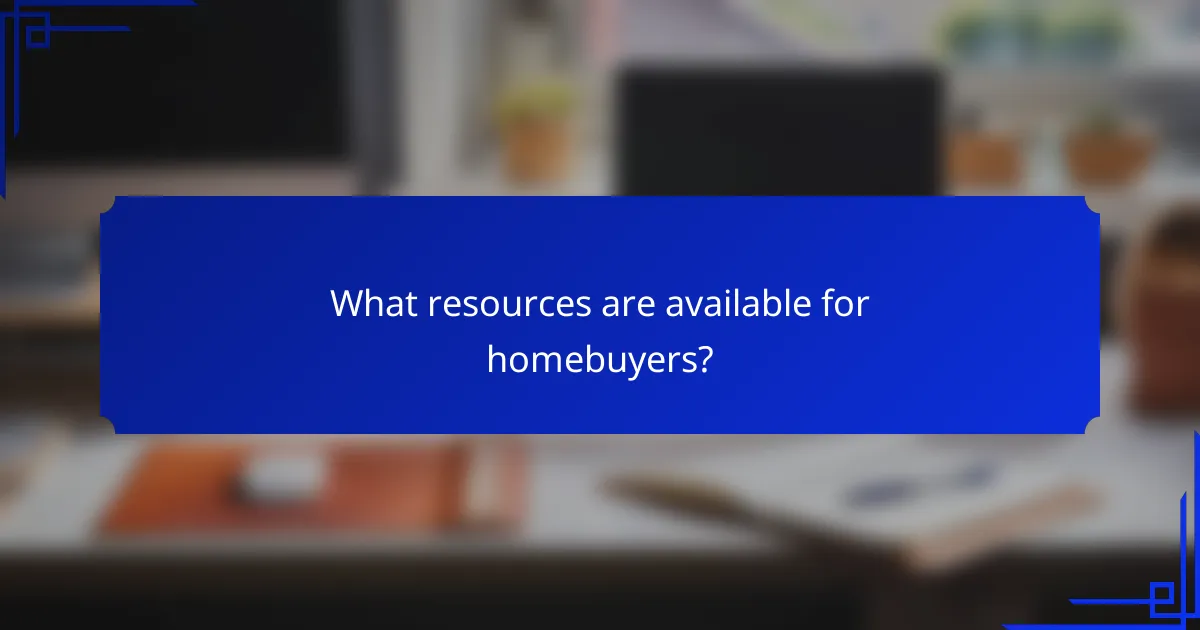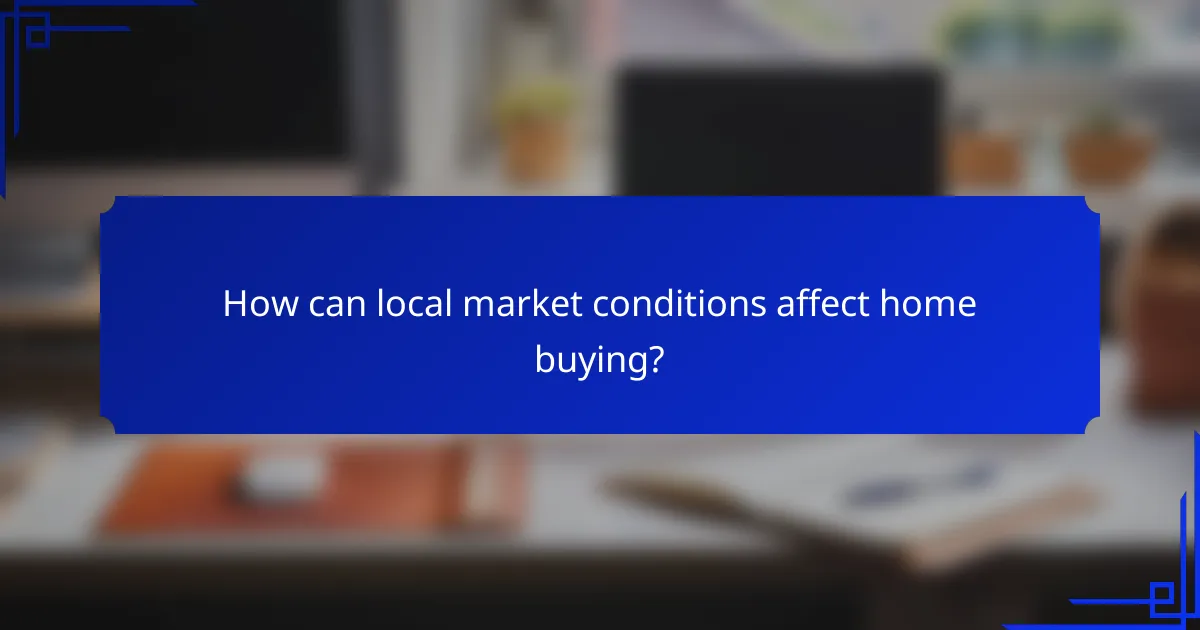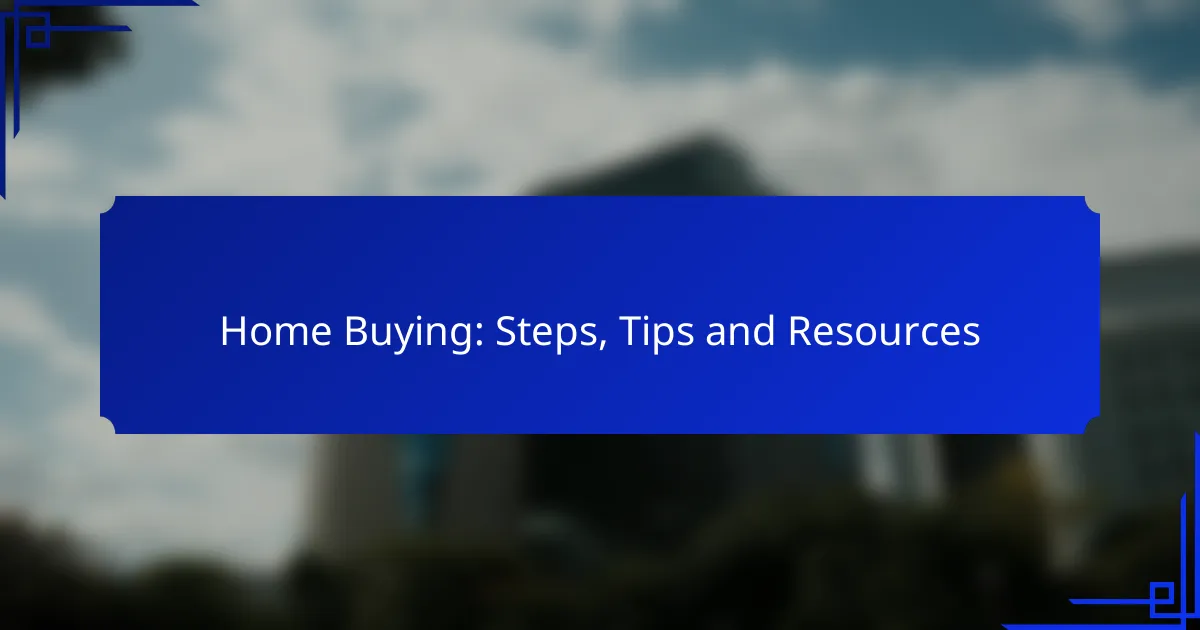Buying a home in the US is a significant milestone that involves several essential steps, from initial planning to closing the sale. By understanding these steps and utilizing practical tips, first-time homebuyers can navigate the process more effectively, ensuring informed decisions and a smoother experience. Additionally, a variety of resources are available to assist buyers, including online tools and educational programs tailored to different financial situations.

What are the steps to buy a home in the US?
Buying a home in the US involves several key steps that guide you from initial planning to closing the sale. Understanding these steps can help streamline the process and ensure you make informed decisions.
Pre-approval for a mortgage
The first step in the home buying process is obtaining pre-approval for a mortgage. This involves a lender assessing your financial situation to determine how much they are willing to lend you, which helps set your budget for house hunting.
To get pre-approved, you will need to provide documentation such as income statements, credit history, and debt information. This process usually takes a few days and can give you a competitive edge when making offers.
Finding a real estate agent
Choosing a qualified real estate agent is crucial for navigating the home buying process. An experienced agent can provide valuable insights into the local market, help you find suitable properties, and negotiate on your behalf.
When selecting an agent, consider their track record, local knowledge, and communication style. Personal referrals and online reviews can be helpful in finding someone who aligns with your needs.
Searching for properties
Once you have your pre-approval and a real estate agent, you can start searching for properties that fit your criteria. This involves looking at listings online, attending open houses, and visiting homes in person.
Focus on key factors such as location, size, amenities, and price. Make a list of must-haves and nice-to-haves to help narrow down your options effectively.
Making an offer
After finding a property you like, the next step is to make an offer. Your real estate agent will help you draft an offer letter that includes your proposed price and any contingencies, such as financing or inspection requirements.
Be prepared for negotiations, as sellers may counter your offer. Understanding the local market can help you determine a fair offer price and improve your chances of acceptance.
Closing the sale
Closing is the final step in the home buying process, where ownership is officially transferred. This involves signing a series of documents, paying closing costs, and finalizing your mortgage.
Closing costs typically range from 2% to 5% of the purchase price and can include fees for inspections, title insurance, and attorney services. Ensure you review all documents carefully and ask questions if anything is unclear before signing.

What tips can help first-time homebuyers?
First-time homebuyers can benefit from practical tips that simplify the buying process. Key strategies include budgeting for additional costs, researching neighborhoods thoroughly, and understanding current market trends.
Budgeting for additional costs
When buying a home, it’s crucial to budget for costs beyond the purchase price. These can include closing costs, which typically range from 2% to 5% of the home’s price, property taxes, homeowners insurance, and potential maintenance expenses.
Consider setting aside funds for unexpected repairs or renovations. A good rule of thumb is to allocate about 1% of the home’s value annually for maintenance. This proactive approach helps avoid financial strain after the purchase.
Researching neighborhoods
Thorough neighborhood research is essential for making an informed home purchase. Look into factors such as local schools, crime rates, amenities, and future development plans. Websites and local forums can provide valuable insights from current residents.
Visit neighborhoods at different times of the day and week to gauge traffic patterns and community activity. This firsthand experience can help you determine if a neighborhood aligns with your lifestyle and preferences.
Understanding market trends
Being aware of market trends can significantly impact your buying decision. Monitor housing prices, inventory levels, and average days on the market in your desired areas. This information can help you identify whether it’s a buyer’s or seller’s market.
Engage with a local real estate agent who can provide insights into market dynamics and help you navigate negotiations effectively. Understanding these trends can empower you to make a competitive offer when you find the right home.

What resources are available for homebuyers?
Homebuyers have access to various resources that can simplify the purchasing process and provide essential information. These resources include online tools, educational programs, and government assistance options that cater to different needs and financial situations.
Online mortgage calculators
Online mortgage calculators are valuable tools that help potential buyers estimate their monthly payments based on loan amount, interest rate, and loan term. By inputting different variables, users can see how changes in these factors affect their payments, allowing for better budgeting.
Many calculators also provide insights into total interest paid over the life of the loan and can help determine how much house you can afford. It’s advisable to use multiple calculators to compare results and ensure accuracy.
Homebuyer education programs
Homebuyer education programs offer workshops and courses designed to educate prospective buyers about the home buying process. These programs cover topics such as budgeting, mortgage options, and the importance of credit scores.
Many local housing authorities and nonprofit organizations provide these programs, often at little to no cost. Completing a homebuyer education course may also qualify participants for certain financial assistance programs or favorable loan terms.
Government assistance programs
Government assistance programs can provide financial support to first-time homebuyers or those with low to moderate incomes. These programs may include down payment assistance, grants, or favorable loan terms through agencies like the Federal Housing Administration (FHA) or state housing finance agencies.
Eligibility requirements vary by program, so it’s crucial to research options available in your area. Many states offer specific programs that can significantly reduce the upfront costs of buying a home, making homeownership more accessible.

What criteria should you consider when choosing a mortgage?
When choosing a mortgage, consider interest rates, loan types, and term lengths. These factors significantly impact your monthly payments and overall financial commitment.
Interest rates
Interest rates determine how much you will pay in addition to the principal amount borrowed. They can be fixed, meaning they stay the same throughout the loan, or variable, which can fluctuate based on market conditions. A lower interest rate can save you thousands over the life of the loan.
When comparing rates, look for annual percentage rates (APRs) as they include both the interest and any additional fees. In the U.S., rates can vary widely, often ranging from low to mid single digits, depending on your credit score and market conditions.
Loan types
There are several types of mortgage loans, including conventional, FHA, VA, and USDA loans. Conventional loans are not insured by the government and typically require a higher credit score, while FHA loans are designed for first-time buyers and have lower credit requirements.
VA loans are available for veterans and active military personnel, offering favorable terms without requiring a down payment. USDA loans support rural homebuyers, often with low-interest rates and no down payment. Understanding the differences can help you choose the best fit for your financial situation.
Term length
The term length of a mortgage affects both your monthly payments and the total interest paid over time. Common terms are 15, 20, or 30 years. A shorter term usually means higher monthly payments but less interest paid overall, while a longer term results in lower payments but more interest accrued.
Consider your financial goals when selecting a term. If you plan to stay in your home long-term, a 30-year mortgage may be suitable. However, if you can afford higher payments and want to pay off your mortgage sooner, a 15-year term could save you money in interest.

How can local market conditions affect home buying?
Local market conditions significantly influence home buying by impacting pricing, availability, and competition. Understanding these factors can help buyers make informed decisions and strategize effectively.
Inventory levels
Inventory levels refer to the number of homes available for sale in a specific area. When inventory is low, competition among buyers increases, often leading to higher prices and quicker sales. Conversely, a high inventory level can result in lower prices and more negotiating power for buyers.
In a seller’s market, where inventory is limited, homes may receive multiple offers, sometimes above the asking price. In contrast, a buyer’s market, characterized by an abundance of homes, allows buyers to take their time and potentially secure better deals.
To gauge inventory levels, monitor local real estate listings and market reports. A good rule of thumb is to look for a balanced market where the months of inventory available is between four to six months. If it’s significantly lower or higher, adjust your buying strategy accordingly.
